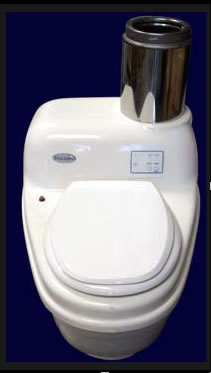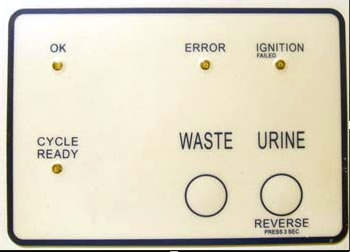|

Comfort Station for the Boonies - and an Industry Giant HonoredBy Jim Bray Leave it to technology coupled with a healthy does of entrepreneurial ingenuity to solve some of life's most pressing problems. In this case, thanks to the folks at Global Inventive Industries, the question of how to use a water closet when there's no water around has been answered – and these people, inventors of the EcoJohn, are undoubtedly flushed with success. Not only that, but bears in the woods – along with human beings – can now spell relief in a clean, environmentally friendly manner that could just make the venerable one-or-two holer a thing of the past. The EcoJohn line of waterless loos was developed in Sweden and is meant for use by people in remote locations – undoubtedly even where trees and leaves may not be close at hand – though you do need some kind of electrical power source. Their lower end – no pun intended – model, the EcoJohn Basic, is billed as a separating, drying and composting toilet that sells for about bout $1100. Higher up the inventory list, the EcoJohn Sr. is a gas-fired unit that incinerates "dude droppings" using propane, turning it into a sterile, er, ash the company says you only need to empty a few times per year. Talk about spiffy biffies! The company claims that installing the EcoJohn is extremely simple once, I assume, you get it physically to the remote location where you need it. All you apparently have to do to get the Senior model up and, er, running, for example, is connect its chimney, hook up the Propane and plug it in. From then, the incineration process happens every time you flush, using a small flame I assume can differentiate between propane and various other gases, otherwise some customers might get pretty bummed out and quite sore at the manufacturer.
GII claims the units are robust and easy to use, with very few, um, moving parts. I haven't actually tested one of these waterless water closets, but rather than pooh poohing the concept out of hand, I'm of the opinion that if the products work as advertised they could just be the best comfort station past the ranger station. The company also markets a line of single and double unit porta-potty trailer things that can be used at work sites, baseball diamonds or wherever else people may need to heed the call of nature. A Toole for Critical Listening The annual CEDIA trade show wrapped up in Denver a few weeks ago, a fact that may bring a rousing round of "so whats" to people who don't live and breathe Custom Electronic Design & Installation – which is a fancy way of saying built in audio/video and home automation systems. But what you might find interesting is that the group behind the CEDIA event chose this year's show to honor a Canadian innovator for his lifetime of achievement in the field. You may not have heard about Doctor Floyd E. Toole either, but his name means a lot to audiophiles, especially to companies who manufacture audio system loudspeakers. You see, Dr. Toole is a pioneer in acoustics research with more than 40 years’ experience in the industry, and thanks in part to his team's work Canadian-built loudspeakers compete with any in the world. And it turns out Canada was only the beginning. From his digs at the National Research Council in Ottawa, Dr. Toole looked into the acoustics of small rooms and the relationship between the technical measurements of audio equipment and how they relate to the perception of listeners. As audiophiles know, specifications don't tell the whole story and should only be used as a guideline, the same way horsepower and torque figures aren't the be-all and end-all when it comes to judging cars. This means the proof of a speaker's pudding is in the listening, and Dr. Toole helped speaker companies improve their products with strictly controlled listening tests using expert and non-expert participants alike. I interviewed Doctor Toole at the NRC back when I was a wet-behind-the-ears writer who loved fine audio equipment but who was then – as now – more of a fan than a nuts and bolts guy. He and his people sat me down in their special room for some blind listening tests I figured were probably designed as much to see if I was worth their valuable time as it was for rating speakers. But I could hear subtle differences and was surprised to find I agreed with the experts' opinions of the speakers we auditioned – much to my relief, because I'd been petrified that I'd reveal myself as just another poseur from the media. That came later and had nothing to do with Dr. Toole… Anyway, after the NRC, Dr. Toole worked for Harmon International, which makes JBL and Infinity speakers. And I can still sense his influence – or so I perceive: I'm reviewing a 5.1 surround set of JBL speakers right now that are affordable, efficient, and which sound so great in my living room I'm thinking of Krazy Gluing them to the floor so I can't send them back. Dr. Toole was apparently not involved in the creation of these particular speakers, but I wouldn't be surprised if his influence were felt right across the organization. Why have him there, otherwise? Thanks for your work, Dr. Toole, and congratulations on your well-deserved lifetime achievement award. Copyright 2008 Jim Bray Jim Bray's columns are available through the TechnoFile Syndicate. We welcome your comments! |
|
|||
 The propane tank is said to be good for 200 flushes and the unit also comes with a reservoir that holds about a liter of water that can be used to rinse out the bowl if necessary. That kind of takes away some of the waterless aspect, though on the other hand I imagine it'd be pretty easy to restock the reservoir when you change propane tanks.
The propane tank is said to be good for 200 flushes and the unit also comes with a reservoir that holds about a liter of water that can be used to rinse out the bowl if necessary. That kind of takes away some of the waterless aspect, though on the other hand I imagine it'd be pretty easy to restock the reservoir when you change propane tanks.